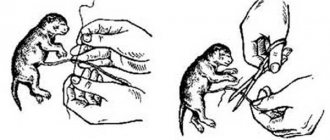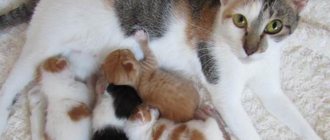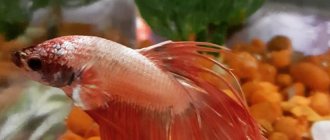Features of development of kittens at 4 months
By the age of four months, the growth of kittens gradually slows down, but full formation has not yet occurred. Muscles continue to develop, and the weight approaches that of an adult animal.
Feeding during this period should correspond to the developmental characteristics of kittens at 4 months:
- Continued active exploration of the environment. Despite the fact that babies are becoming more and more similar to their adult counterparts, pampering, playfulness and activity remain in their behavior. This requires high energy costs and adequate nutrition.
- Intensive development of muscles and skeletal system. Four months of age is the stage when the body becomes stronger and approaches the development of adult cats. This process requires an increased amount of nutrients and nutrients (vitamins, minerals).
- Changing baby teeth. By 4 months the change of teeth begins. For the health of permanent teeth, the body must receive a certain amount of minerals, which kittens receive only with food. When teething, animals experience an itchy feeling in the gums, which can be relieved by including soft boiled cartilage in the diet. They will also help your pet learn to chew properly.
- Lactic sugar intolerance. At four months of age, 40–50% of kittens become more sensitive to lactose. This is expressed by diarrhea, which is observed almost immediately after drinking whole milk, especially cow's milk. Veterinarians associate this point with a gradual decrease in enzymes in the intestines, which are transmitted through mother's milk.
- Balance in nutrition. The period from 4 to 6 months is important because there is an urgent need to monitor the caloric content of the diet. If the kitten is malnourished, it will quickly lose weight and become weak. If the caloric intake is exceeded, the opposite situation will occur; the baby will begin to rapidly gain weight, even with high activity.
- Lack of appetite control. This is a serious problem, so portions should be placed in a bowl in measured doses. If you add the daily amount of food at one time, the kitten will not be able to stop and will eat a lot. Then he will ask for food again.
Developmental features determined the feeding regime and the list of products for kittens. Usually, at 4 months, babies are given to new owners, so it is recommended to ask the breeder how the pet ate .
If the baby was taken from the street or nothing is known about its feeding for other reasons, then you should decide on the type of food that will be given to the kitten.
Adjustment of the norm
Let us remind you that you should pour food into a bowl once or twice a day strictly according to the norm and monitor how quickly the food runs out and whether the kitten shows signs of hunger. If you decide to give out food twice, do not forget to divide the daily amount into two parts.
When calculating the norm, you should also take into account the additional nutrition that the kitten receives - most often, these are various treats. They should make up no more than 10% of the total food volume.
Carefully monitor how much food your pet eats per day, because in the first year of a kitten’s life you will have to adjust feeding rates quite often due to the animal’s growth.
If the kitten has normal body condition and weight, then everything is fine and there is no need to adjust the norm. In all other cases, it is necessary to increase or decrease the norm, since underfeeding and overfeeding a baby can affect the health and longevity of an adult animal.
What to feed a kitten
Four months is a difficult stage for a small animal. This is influenced by stress factors: moving, new surroundings, changing baby teeth, deworming, vaccinations. Against the background of emotional fatigue, the kitten may be malnourished, lose weight, and suffer from digestive disorders.
Food and products for feeding kittens
Having decided on the frequency of feeding the babies, all that remains is to choose what to feed. As a rule, kittens can receive 3 types of food:
- Ready-made - special food for kittens (dry - in granules or wet - in the form of canned food, liquid cereals, etc.).
- Natural (homemade) - made from products from the owner’s table.
- Mixed - including 2 of the above types of food.
Specialized food is considered the healthiest food for kittens, since it contains a set of all important vitamins and microelements in optimal dosages. Delicious food from the table is not able to satisfy all the needs of a developing organism. In addition, the content of salt, spices and other food additives can harm the gastrointestinal tract. Despite this, you should not buy the first boxes of food you come across in the store. Look at the product description and the kitten's age indicated on the package.
Choosing food for a kitten
Kittens need to drink enough water, so there should always be a cup of clean water next to their food bowl. If your fur babies don't drink water after eating dry food, add more liquid food to their daily diet. The main thing is to adhere to the ratio of 1 to 3: for every gram of dry food, the kitten needs 3 milligrams of water.
Feeding mode
The feeding regimen is set depending on the breed, weight, activity, and health of the animal. The larger and more playful the kitten, the more food it needs to develop normally.
Veterinarians advise creating a different menu for each week. The number of feedings for a four-month-old kitten is 4 main meals and 1-2 snacks.
150–200 grams of food per 1 kg of body weight per day will be enough. The total amount of food is divided evenly into the number of meals.
Allowed snacks are boiled chicken yolk, a piece of meat or fish, a small portion of cottage cheese.
If the kitten does not eat vegetables, they can be replaced with grass or vitamin supplements.
Exhausted kittens need to be fed more often
At the same time, there are cases when the above rules for calculating how much dry food a kitten should be given per day are not taken into account. We are talking about selected emaciated animals that need to be fed fractionally several times a day so that their body can gradually adapt to an increase in the volume of food.
If a hungry animal immediately begins to feed to its fullest, this can lead to severe digestive disorders, vomiting and other, much more serious consequences. Only when the kitten gains weight in accordance with its age can you move on to rationed feeding.
Vitamins and supplements
Vitamins and supplements are included in the diet only when feeding natural products. This happens on an ongoing basis until the pet reaches 1 year of age. If the diet consists of industrial feed, then supplements are given only on the recommendation of a veterinarian.
Natural sources of nutrients include liver, vegetables, herbs, meat and bone meal, vegetable oils, and yeast. Additionally, you will need pharmacy vitamin complexes or one-component products: omega-3, fish oil, calcium supplements.
Be sure to include foods rich in taurine in your diet: turkey, rabbit, chicken by-products, homemade yogurt, sea fish.
The amino acid is necessary to strengthen the immune system, improve the functioning of the liver, kidneys, heart, brain, and normalize digestion.
What should be the diet of a 4 month old kitten?
Having chosen your feeding method, do not change it often, otherwise this approach to feeding will have unpredictable consequences for the baby. You cannot use two ways to feed a kitten at the same time - eating ready-made kitten food and natural food.
Veterinarians say that:
• Your clients will probably have digestive problems, which can cause gastrointestinal diseases;
• Too large a dose of vitamins for an animal can cause hypervitaminosis.
Natural nutrition
At the age of 3-4 months, the kitten's milk teeth are replaced, at which time protein-rich solid food should appear in its diet. It is necessary to diversify the dairy diet; veterinarians recommend introducing vegetables into the diet, which contain many different vitamins. You need to include a lot of meat ingredients, the amount of vegetables and porridge can be increased to 50% of the daily food intake. It is impossible not to give meat to a kitten at all; it contains the substance taurine, which is extremely necessary for good vision and heart health.
Important! We must not forget that natural nutrition does not mean using food from your table.
For a 4-month-old kitten, veterinarians recommend adding the following products to the diet:
• In the diet of a 4-month-old kitten, there must be lean boiled meat - beef is best, minced meat or finely chopped turkey or chicken fillet is also suitable (if the baby does not have worms, then it is allowed to give a little proven raw frozen meat);
• Fermented milk products and skim milk without foreign additives – fermented baked milk, kefir;
• Low-fat cottage cheese, which the baby needs to strengthen bones and teeth (it is advisable to start with the finished product, for example, “Agusha” cottage cheese);
• Various vegetables - cabbage, zucchini, pumpkin, grated, but if the baby does not want to eat them just like that, then you can prepare vegetable mixtures with boiled cereals;
• Boiled or raw crushed egg yolk;
• Low-fat fish (preferably sea fish; river fish can give a kitten worms);
• Cereals – boiled in meat or vegetable broth, milk or even water (rice and semolina are better suited for a cat’s body);
• Special grass (can be purchased at a veterinary pharmacy or pet store, or grown on your windowsill; wheat or oat sprouts are suitable);
• A little vegetable oil for digestion.
Features and rules of feeding
It is necessary to feed a kitten at 3-4 months in accordance with certain rules:
- Meals should be done frequently, but in small portions.
- Feed food at room temperature.
- The diet is enriched with vitamins and minerals. If necessary, we provide them additionally.
- Clean, fresh water is freely available.
- Overeating or undereating should not be allowed. This can cause complications such as developmental delay syndrome if the body does not get enough nutrients and excess weight if the body gets too many nutrients.
- It is necessary to give foods that the kitten will chew, thereby massaging the gums.
How to accustom a kitten to dry kibble
When buying a kitten from a breeder, you should definitely find out what it was fed. It’s good if the new family member is already accustomed to industrial nutrition. If the kitten ate natural foods, it is necessary to accustom it to new food gradually.
During the 2 weeks of being in the new home, the pet should eat its usual food.
Dry food is introduced into the diet slowly:
- The granules can be placed in a bowl of natural products. Gradually, the amount of usual food should be reduced by adding more granules. As soon as the owner notices that the kitten is calmly eating the new dish and, even better, gives preference to it, this means that the baby is ready to completely switch to industrial food.
- What to do if the animal does not want to eat pellets, but only eats foods that are familiar to it? In this case, dry food must be soaked. The granules need to be filled with liquid. This can be milk, water, vegetable or meat lean broth. After mixing, let stand until the granules are completely swollen. Then they should be thoroughly mashed with a fork and given to the baby. When the kitten gets used to it, you need to knead the granules less and less, adding hard pads to them.
- Soaked dry food should not be kept in a bowl for a long time. Unlike granules in their pure form, soaked ones deteriorate very quickly. Immediately after feeding, food must be put in the refrigerator. As an option, prepare only as much food as the kitten can eat.
Special attention. During the transition from natural food to industrial dry food, it is important to monitor the condition of the kitten. The risk of allergic reactions or digestive disorders cannot be excluded. This rule also applies to cases where the kitten was initially accustomed to dry food, but the owner changes the class of the product or manufacturer.
How to measure food correctly?
When you have calculated how many grams of food a kitten needs, one more question remains: how to accurately measure the right amount? The easiest way is to use a measuring container that is designed for these products. You should not use cups from dry food of other brands for measurements. This is due to the fact that the density and size of the granules are not the same for different brands, which means that the error can be very large.
If there is no cup, but there are electronic scales in the kitchen, weigh the food on them and select a container of the appropriate size. However, with a small kitten this option may be inconvenient, since the feeding rate must be constantly adjusted. A transparent plastic cup and a permanent marker will help: weigh 10 g on the scale, pour the granules into a glass and make a horizontal mark on it, then another 10 and so on. You will get a universal measuring container that will remain relevant even when your pet grows up.
What to do if there is neither a special glass nor scales? When the packaging is small, the food can be easily divided into equal parts. For example, we divide 340 grams into 10 parts and get a portion equal to 34 grams. But when buying a large bag of product, this method of measurement will be too troublesome and inaccurate. Therefore, if you don’t have kitchen scales in your home, we recommend purchasing them. They will be very useful to you not only in feeding your pet, but also in the household in general.
Ready-made feed
The composition of industrial feeds is already balanced. This diet is enriched with vitamin and mineral supplements necessary for the development of the kitten. There are dry and wet food. When feeding, it is better to give preference to one type of food. If you still decide to use both dry and wet food, then separate them and feed them at different meals.
Advantages of ready-made feed:
- Convenience. Such food saves time that would have to be spent on cooking.
- The feed is already balanced.
- When eating dry food, the kitten actively works with its jaws, which puts the necessary load on the entire oral apparatus. This stimulation promotes proper development of the jaw muscles and bones.
- Among the ready-made foods there is a large selection of lines according to the tastes and physiological state of the pet.
Disadvantages of ready-made feeds:
- High quality feed has a high cost.
- It is difficult to choose food among a large number of different brands.
- Dependence on economy-class flavor enhancers is developing.
Rules for feeding a 3 month old kitten dry food:
- Feed should be given in accordance with the norm indicated on the package.
- The food must correspond to the type of animal, its age and physiological condition.
- It is better to feed the same brand and line of food.
- When feeding dry food, clean water should be nearby.
- Food should not sit in a bowl; such food becomes of poor quality.
Acana
Canadian-made food belongs to the super-premium class. The composition is good, does not contain cereals. Fresh (8%) and raw (8%) meat, fresh whole eggs (8%), as well as dehydrated poultry (8%), and offal are used as a source of protein. The total amount of protein products is 35%. There are useful ingredients such as: apple, pear, cranberry, brown algae, carrots, pumpkin and others.
Only dry food with fish, lamb and chicken flavors is available for sale.
The feeding rate for kittens 5-20 weeks is 60 grams per kg of weight.
Royal Canin
Premium food. The protein content in wet food is 10-12%, and in dry food 36%. The protein in this food is mainly vegetable. Excess amount of carbohydrates. There are also corn flour, dry beet pulp, and soybean components.
This brand of food contains mainly poultry meat. Royal Canin brand food is presented in the form of canned pates, wet and dry ready-made food.
For babies aged three months, you should choose Royal Canin MOTHER&BABYCAT food - this food is perfect for feeding kittens from 1 to 4 months. For a four-month-old kitten, Royal Canin Kitten food is suitable. This food can be fed to kittens from 4 to 12 months.
During the day, the baby will need 50-65 g and 55-70 g, respectively.
Bosch Sanabelle Kitten
This food belongs to the same class as Royal Canin. The composition contains all the necessary components. Fresh poultry meat – 25%, fresh liver – 5%. The composition is enriched with fiber, eggs, animal fats, calcium supplements and brewer's yeast. Also in the list of ingredients there are those that can cause allergies - these are maize and cellulose.
Kittens can eat this food for up to a year, and it is also suitable for pregnant and lactating cats. You can choose either dry food or wet food.
The feeding rate is 55-60 g and 60-65 g, respectively.
How and what to feed a kitten correctly - from birth to 4 months
You have a new resident in your house - a kitten. A soft fluffy little ball, still very stupid and completely defenseless. It doesn’t matter whether you took it from friends, bought it at a poultry market, or, feeling sorry for it, picked it up on the street, abandoned by a soulless person to certain death. The main thing is that the cat's mother is not next to him.
The future of the animal is in your hands. The worries of feeding your baby now fall on your shoulders. To do this, you need to know what and how to properly feed a kitten at different stages of its life in order to raise a healthy and active animal.
What to feed a kitten
The main factor determining a kitten's diet is the pet's age. While he is still very small, up to one month, it is better to leave fatty and heavy foods for later and pay attention to the milk, it also should not be from cows, it is better to purchase a factory-produced cat milk substitute mixture. You can add low-fat cottage cheese or kefir to his diet as soon as the animal reaches one month. After another half a month, the kitten will eat on its own. So, what products and how to feed a small kitten correctly?
Meat is what the kitten needs first of all, but it should not be raw; you can boil it or scald it with boiling water. Poultry and chicken meat is also necessary for the baby to get adequate nutrition, but there is a small nuance here: before feeding it to the animal, make sure that there are no bones in it so that the kitten does not choke. It is recommended to start giving meat to a kitten at two months of age; very young children will find it difficult to digest heavy protein foods. Knowing what to feed a kitten correctly and what not to feed it is the basis for its good health in the initial stages of life, especially up to two months of age.
Vegetables are very useful, as they contain many vitamins; it is advisable that they be boiled. It is better to teach a kitten to eat vegetables from a young age, and if you do not do this in the first months of life, then it is likely that when your pet grows up, he will turn his nose up at boiled carrots or beets. The fish should also be boneless, and it is recommended that the kitten eat boiled fish.
You need to be careful when feeding a kitten eggs - it is contraindicated for them to be boiled, since the animal’s body does not digest them.
Make sure your kitten has only fresh water every day.
Cheese also contains many vitamins, but caution again will not hurt - feeding it 2 times a week will be quite sufficient.
For clarity, here is a small cheat sheet on how and what to properly feed small kittens at an early age:
| Age | Diet | Frequency |
| 1 month | Liquid semolina porridge, mashed egg white, formula from a pet store | 4-5 times a day |
| 2 months | Low-fat calcined cottage cheese, boiled meat (no more than 15 grams at a time, liquid porridge, soft cheese, milk or cream | 4 times a day |
| 3 months | Boiled or raw meat (preferably chicken), egg yolk, cream or kefir, boiled vegetables, porridge | 3-4 times a day |
| 4 months and older | Meat pieces, raw or boiled (25-50 grams), any fermented milk products, pieces of vegetables and fruits, rye bread or crackers, cereals | 3 times a day |
What to feed a newborn kitten
It's great if kittens grow up with their mother. Maternal instinct tells the cat when to feed the babies, how to take care of their hygiene, and how to teach the kittens to be independent.
What to do if the kitten is orphaned from birth? Alas, this is not uncommon. Some mercilessly throw blind newborn kittens into the street or throw them in other people's yards, others, out of compassion and love for animals, take them into their apartments.
And here problems arise: the baby still does not know how to lap from a bowl. How to feed him? What exactly should I feed? How many times a day should an animal eat?
It’s a great success when you manage to find a nursing cat and try to give her an adopted one. Unfortunately, this is quite difficult to do, especially in the city. This means you will have to feed the small newborn kitten yourself.
If the kitten is still very young, then it will need to be fed every two hours, this also applies at night. To feed the baby, you can use a baby syringe or a small syringe without a needle. You can also look for a special pacifier for feeding kittens.
There is a common belief that cow's milk is best suited for feeding any animal. However, its composition is very different from that of a cat (a cat is a predator!) and is difficult to digest in the kitten’s body. It is better to purchase a cat milk substitute at a specialized pet store or veterinary pharmacy.
If this is not possible for some reason, then there is a recipe for preparing a mixture for newborn kittens at home.
A two-week-old kitten can be fed only once at night and every 2-3 hours during the day. The baby should be full, but not overeat. Therefore, 5 ml of food at a time will be enough for him.
What to feed a kitten at 1 and 2 months
Adherents of ready-made cat food can start feeding their baby canned food for the smallest kittens from the age of one month. Do you really love your pet? In this case, avoid canned and dry food of the Whiskas and Kitty-Kat brands. They will bring nothing but harm to the kitten. A good option for two-month-old kittens is Gourmet food. At an early stage of life, stop using dry store-bought food - it is dangerous for the kitten and can lead to problems with the gastrointestinal tract! The fundamental rules of proper nutrition for a kitten should not be neglected!
You can start feeding your cat baby regular baby food, gradually adding pureed cottage cheese, boiled beef, vegetables and low-fat kefir to the diet. Be sure to give your kitten vitamin supplements with calcium and phosphorus. At this stage of development, the kitten is already ready to digest heavier food, but it will still be a difficult test for a 2-month-old cat to digest some types of food that an adult cat can afford.
At the age of 1-2 months, the kitten is taught to eat independently from a bowl.
Useful recommendations on feeding one-month-old kittens are presented in the video:
What to feed a kitten at 3-4 months
Veterinarians and breeders recommend introducing a mixed diet from this age, that is, giving both ready-made cat food and natural products. Natural products do not mean food from the master's table. A kitten aged three months needs to be prepared separately.
We should never forget that a cat is a predator whose diet is based on food of animal origin. From 3-4 months, in addition to boiled beef, the kitten can be given a little boiled chicken with buckwheat or rice.
Only sea fish is suitable, lean, boneless, and boiled. You should periodically give your kitten a boiled yolk. Veterinarians concluded that kittens cannot digest egg white. The kitten will receive the necessary vitamins from canned cat food and dry food. Experts advise choosing Royal Canin and Hills food; for kittens 3-4 months old this will be the best choice for nutrition.
What to feed a kitten older than 4 months
During this period, the kitten is actively growing and gaining weight. This does not mean which animal needs to be overfed. You should include foods that increase muscle mass in your diet, not fat deposits.
An immutable rule regarding meat: beef must be cooked for 30 minutes! You can also give it raw, but only defrosted and kept in the freezer for at least 3 days. This also applies to beef offal. 50 g per day is enough for proper feeding of a kitten.
Give chicken meat and chicken by-products only in boiled form and no more than 3 times a week. It is enough to feed your kitten boiled sea fish once a week.
Not every kitten will eat cereal porridge in its pure form, so it is better to mix it with boiled meat or fish. Raw pureed vegetables or chopped boiled vegetables can also be mixed into these porridges. It is recommended to add a few drops of vegetable oil.
Continue giving chicken yolk 1-2 times a week. Fermented baked milk and yogurt can be added to fermented milk products.
After four months of life, the kitten gradually turns into an adult cat or feline, with already formed preferences in nutrition and diet.
What not to feed a kitten
To ensure that the kitten does not have health problems, the following foods must be completely excluded from its diet:
- sausages of any kind;
- fatty dairy products, butter;
- raw freshwater fish - this will protect your pet from parasites;
- pork in any form, as well as lard;
- Bird bones are very dangerous for kittens (also for adult cats, and even dogs). They are hollow; sharp fragments can damage the animal’s esophagus or stomach.
This short list of foods that you should not feed to your kitten can be printed out and hung on the refrigerator door, and every time you want to feed your little cat something from your refrigerator, check this list!
If you follow these simple rules regarding what it is strictly forbidden to feed a kitten, then soon a healthy, strong and cheerful family pet will grow from a small, unintelligent animal.
How many times a day should you feed a kitten?
After you get a small pet, you may have a question: “How much should a kitten eat?” and what to feed him. In this article you can find the answer to your question and get acquainted with tips on feeding your animal.
At the initial stage of your pet’s life, the main thing is not to overfeed it, since the kitten’s body is not yet configured to consume food in large quantities and you can unwittingly harm it, not knowing how many times a day you need to feed the kitten.
Therefore, up to two months, feed the animal 5-6 times, but a little at a time, 5 ml of food will be enough. Don’t forget that newborn cats need to be fed in the first weeks of life, even at night! If everything is normal with the animal’s health, then its hungry squeak will be an excellent signal that it’s time to eat.
When he grows a little, at 3-4 months of life, feeding 4 times a day will be optimal.
As soon as the baby turns 8 months old, you can safely feed him like an adult cat - 2 times a day.
Types of dry food for kittens
In order for your pet to receive all the nutrients important for its growth and development, you need to choose the right food. When purchasing, you should focus not only on the price, but also on the composition of the product. Dry food classes:
- Holistic foods are the most expensive foods that cannot always be found on sale in pet stores. This is the best commercial food for kittens 3 months old. Holistic products contain only natural ingredients. The source of protein and the main ingredient is natural meat. There are no components in this product category that can provoke an allergic reaction. The composition is perfectly balanced, all vitamins, macro- and microelements are present.
- Super-premium is not much inferior in quality and balance to holistic products, but costs an order of magnitude cheaper. This is also the best choice for 3 month old kittens.
- Premium is a good food with a high-quality composition, which includes natural ingredients. The source of useful elements is algae extracts. Before purchasing, you need to carefully study the composition, since there may be ingredients that cause allergic reactions in some animals that are intolerant to certain products.
- Economy. It is not recommended to use Whiskas, Friskas and other well-known cheap food to feed a kitten. There are exceptions among them - diets with a high-quality composition, without allergenic products, so before purchasing, be sure to carefully study the text on the packaging. Budget food often contains by-products instead of natural meat. To enhance the taste, food additives can be used, which often cause allergic reactions and indigestion.
When choosing a food category, the owner of a 3-month-old kitten should focus on his financial capabilities.
It is not recommended to change food as the kitten gets older from higher quality to budget food, as this can lead to health problems.











